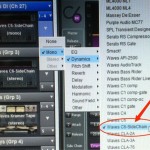
The Rules

After recording the CTW podcast this week, I was thinking about what I said in regards to only using what I absolutely need when mixing. That’s always the goal, but sometimes it’s easy to fall into routines. This week I thought I’d issue myself a little challenge during rehearsal to make sure I really am only using what I need. So I established some rules before soundcheck:
The Rules
1.) No Input Compression for 30 Minutes.
2.) No Looking at EQ Curves While EQ’ing.
3.) No Solo-In-Place for More Than 3 Seconds.
No Input Compression for 30 Minutes
The first rule was designed to stop me from arbitrarily compressing some inputs I almost always compress: bass, snare, and vocals. I used 30 minutes because I knew our soundcheck would take around 20 minutes, and then the next 10 would get through a song. So by 30 minutes I figured the stuff that I really wanted a compressor on would be driving me nuts.
I only wanted to limit myself to input compression because I knew there was some buss compression I wanted from the start: my master L/R compression and parallel compression on the drums. Both of these contribute more to a sound for me than control, and I knew I wanted the sound in there from the start; my buss compressor is usually just tickling 1 dB of compression so I rarely hit this hard. I could have lost the L/R compression, but I knew I’d want to parallel compress the drums. In fact, I worked on the drums for a while with some satisfaction without the parallel compression, but pushing up the parallel compressed bus gave me more of what I really wanted.
No Looking at EQ Curves While EQ’ing
I established this rule because I’ve been mixing so much on digital consoles lately that I’ve been starting to get worried I’m relying on a screen too much especially with vocals. I’ve learned there are two potential danger zones for me when EQ’ing with a screen. On one hand, I think it’s difficult for me to EQ heavily because seeing enormous cuts or boosts tends to freak me out like I’m doing something wrong; this might actually be a good thing most of the time because it pushes me to explore other options than EQ. On the other hand, I feel like the visual of the EQ might be influencing where I put the filters, and I want to make sure I’m relying on my ears for this.
No Solo-In-Place for More Than 3 Seconds
Solo-In-Place is a blessing and a curse. I used to have this rule, but I know I’ve been slipping lately so I deliberately brought it back. This is simply an attempt to force me to mix mostly in context. I have an event on the console that will automatically clear a solo-in-place after 3 seconds so this one is hard to break.
So how’d I do?
Well, I broke the first rule and compressed a lead vocal right off the bat without thinking, but it was pretty evident it needed it so I didn’t feel too bad. Outside of that, I adhered to the rule. By the end of the 30 minutes I was still wanting to compress some things I normally hit, and adding them in gave me what I felt like I was missing.
In regards to the second rule, I had to stop myself from looking at EQ curves a couple of times which proved to me that it really has become a habit to look at the screen. However, without looking at the curves I was still able to EQ what I needed. This was actually a really good rule to implement because it tweaked my ears up a notch in some ways.
The third rule was sort of unbreakable because I set the console to automatically enforce this. This was something I had the least issue with because I was using this for a while last year.
Overall, it was a good exercise to break up some routines. I wouldn’t necessarily recommend everyone try these particular rules since I picked them to try and keep me from falling into some of my own traps. But if you feel like you’re falling into too much of a routine maybe some rules of your own are in order.
What are some rules that might help out your mixes?

 Previous Post
Previous Post Next Post
Next Post



The one place I bend the rules on Solo In Place is when I solo VCA’s or Groups. I want to hear the overall balance of my drums or vocals.
My one rule (partially because we mix monitors from FOH) is that i only make fader, pan and FX changes the first time I listen through the entire set. This prevents me from over-tweaking and changing too much of what the musicians will hear between rehearsal and Sunday morning.